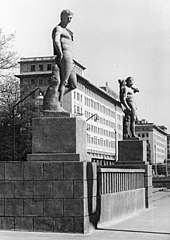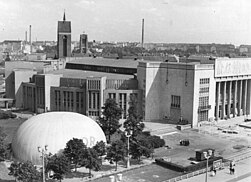German sports hall
| German sports hall club of youth and athletes |
|
|---|---|

|
|
| Entrance building of the German Sports Hall, 1952 | |
| Data | |
| place | Berlin , Germany |
| Coordinates | 52 ° 31 '5.9 " N , 13 ° 26' 5.4" E |
| owner | Magistrate of Berlin |
| start of building | March 1951 |
| opening | 2nd August 1951 |
| demolition | 1971-1972 |
| architect | Richard Paulick |
The German Sports Hall was a representative sports and event hall in East Berlin , which was built in 1951 in Stalinallee and demolished in 1972.
history
The building was built in 1951 on the occasion of the III. World Festival of Youth and Students based on a design by Richard Paulick built in just 148 days in the style of Socialist Classicism after the contract was awarded on March 8 of the same year. Opposite it on the south side of the avenue rose the Stalin monument, unveiled a day later on August 3, 1951 . The multi-purpose hall was the first building in the monumental representative style of the newly created Stalinallee.
It was a steel and reinforced concrete building in the form of an oval functional building of the modern age with a neoclassical entrance hall in front. The cladding consisted of yellow-brown travertine panels that came from stocks for the National Socialist plans for a “ world capital Germania ”. The main entrance of the 28 meter high hall was designed as a pillar portal with six columns, which since 1952 has been crowned with a wide bas-relief with sporty representations.
In front of the entrance hall, replicas of four monumental sculptures from the Schlüterhof of the Berlin Palace, which was demolished around the same time, found their place on both sides of the stairs of the entrance terrace . Eight colossal statues of gods and demigods stood on the large risalit of the Schlueterhof; copies of these were found in front of the German sports hall Zeus ( Jupiter ) , Meleagros (Meleager) , Antinous (Antinous) and Heracles (Hercules) .
The hall had a competition area of 1,000 square meters - about as much as an indoor handball field including a safety zone - and offered space for 5,000 spectators. The steel girders required for the planned roof structure were not available during construction, so that the building was provided with an auxiliary structure from the start, the pillars of which impaired visibility in the interior of the hall.
After the opening of the hall on August 2, 1951 by the East Berlin mayor Friedrich Ebert - three days before the opening of the World Festival - it was a venue for handball, volleyball and boxing competitions, among other things. In addition to sports comparisons, other events and exhibitions took place in the hall. Among other things, the World Peace Council met in the sports hall in 1952 ; From 1953 the German Building Exhibition took place there several times and in 1958 the first East Berlin fashion week . On the upper floor of the entrance building, the Deutsche Bauakademie ran a permanent exhibition with which it provided information about the further plans for Stalinallee and the reconstruction in the GDR capital. In 1961, the tower of St. Pius Church , which had burned out during World War II , was rebuilt, shortened by around 30 meters, so that it no longer interfered with the appearance of the German sports hall in particular. In November 1961 the Stalin monument was removed and the street section between Frankfurter Tor and Alexanderplatz was renamed Karl-Marx-Allee . In May 1961, the hall, renamed the Central Club of Youth and Sportsmen , served as the starting point for the 8th stage of the International Peace Tour and in August for the opening stage of the GDR Tour 1961 . From 1962 to 1968 it was the focus of the East Berlin Christmas markets .
In 1968 the hall had to be closed for major events due to extensive structural damage and the risk of collapse. The last major event was the meeting of young socialists in the hall in 1969 on the occasion of the 20th anniversary of the GDR, for which there was also an exhibition on 20 Years of the GDR . Here, some new developments such as the textile present 20 were presented and visitors could have their keys coated in a galvanizing bath . On the instructions of the SED , the East Berlin magistrate refrained from repairing the hall in September 1971; The demolition began in the same year and was completed the following year. On its former site was later a block of flats in bricks built (→ image ).
Views
German sports hall and Stalin monument , 1951
Postage stamp of the Deutsche Post , 1953
literature
- Arnt Cobbers: German sports hall . In: Demolished! Disappeared buildings in Berlin . Jaron Verlag, 2015, pp. 52–53, ISBN 978-3-89773-764-8 .
- Herbert Nicolaus, Alexander Obeth: The Stalinallee. History of a German street . Verlag für Bauwesen, Berlin 1997, ISBN 3-345-00605-7 .
Web links
| - gallery |
- Dirk Moldt : The German Sports Hall. In: Friedrichshainer Zeitzeiger , September 1, 2017.
- The German Sports Hall . In: Foto-Melange.de
Individual evidence
- ↑ Gerhard Lehrke: Gods move. Sculptures by Andreas Schlueter change location in Berlin . In: berliner-zeitung.de , February 11, 2019.
- ^ Ralf Schmiedecke: Berlin-Friedrichshain . Sutton Verlag, 2006, p. 120, ISBN 978-3-86680-038-0 .
- ↑ St. Pius Church in the Friedrichshain-Kreuzberg portal.
- ↑ See Tscherepowitsch won in Leipzig . New Germany from May 11, 1961.
- ^ Johanna Tiedtke-Braschos: Building as a political issue. How politics deals with construction projects in Germany in the 20th century . Tectum Verlag Marburg, 2015, p. 266, ISBN 978-3-8288-6187-9 .
- ^ Nicolaus, Obeth (lit.), p. 285





